One in five Americans now shares their homes with adult children, parents or grandparents. In the face of soaring housing costs nationwide, multigenerational living has gained traction as a path to make living expenses more manageable and to maintain closer family bonds.
While many multigenerational families are living together under one roof, potentially leading to feelings of overcrowding, accessory dwelling units (ADUs) have emerged as a practical solution for affordable housing that allows families to stay close while maintaining some separation.
ADUs offer a detached living space where adult children or elderly family members can have their own place to call home. ADUs can help families to stay nearby, share responsibilities of caregiving, keep housing expenses in check and still enjoy privacy and personal space.
Multigenerational housing gains steam to combat affordability pressures
According to a recent survey conducted by OnePoll, 61% of homeowners cited multigenerational housing as their primary motivation for constructing an ADU.
Multigenerational housing can also provide a residence for aging parents or family members in need of additional support or caregiving. According to the same survey, one in four homeowners either house a disabled family member in their ADU or have plans to do so in the future.
Notably, accessibility was an important consideration for 73% of homeowners who have an ADU, whether for the purpose of aging in place in the future or for accommodating current residents.
Multigenerational living is not a new concept. In various parts of the world, it is deeply ingrained in the culture, and it was also common in the United States prior to the 20th century. Families in many parts of the world support one another with childcare and eldercare, fostering robust support systems that cater to all needs.
So, why does this trend appear relatively novel in the United States today?
Since the early 20th century, the American dream has historically centered around starting one’s own family and achieving enough financial success to purchase a home and build durable wealth in that home over time.
This dream was attainable in 1950 when the median home cost just $7,354 and the average family income was $3,300 (both figures not adjusted for inflation), meaning home prices were ~2.2x the typical annual family’s income, according to U.S. Census Bureau data. At the time, mortgage rates were about 4%.
However, factors such as population growth, a scarcity of new entry-level homes and rising inflation have collectively rendered housing — and especially homeownership — increasingly unaffordable and elusive for many.
For comparison, the median home price in 2022 was $457,475 and median household income was $74,580, according to data from the Federal Reserve Bank of St. Louis and the Census Bureau. This means that home prices are now more than six times the typical annual family’s income (and today mortgage rates are north of 7%).
ADUs provide an alternative for multigenerational living
Whether it’s a young family striving to purchase their first home or a retiring couple looking to downsize, the competition for real estate is fierce, and housing costs are prohibitive for many families.
ADUs can add much-needed space to support multigenerational living and they can do this at an affordable price point for homeowners who are looking to build them.
Adding an ADU can be very cost-effective when an existing space is converted (i.e., a garage or basement) or when modern offsite construction is used to build a new structure.
We are seeing more and more homeowners look to modern offsite construction for ADUs because of the low cost, fast speed and sustainability advantages compared to traditional construction methods.
As the benefits of ADUs continue to be realized by more and more homeowners, they offer a promising solution to the challenges posed by rising housing costs and the desire to keep families close, reinforcing the idea that home is not just a place but a space that fosters love, support and togetherness.
Sean Roberts is the CEO of Villa Homes.






